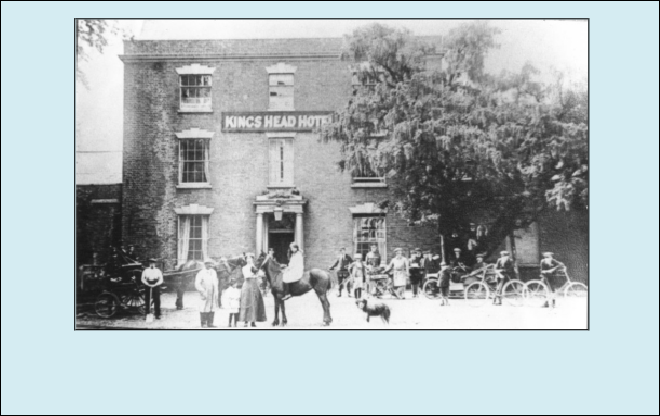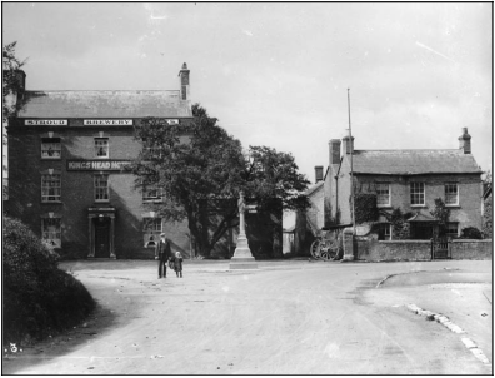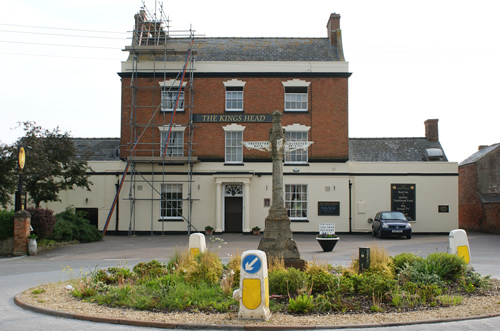


Steve Mills
Published in ECN 144 Apr/May 2014
In 1838, Eastington had two pubs and 23 beershops – the latter were often no more than a converted room in a private house. By 1891, things were a bit more orderly, with the village now having no less than nine pubs! Older residents will probably remember some of these that included the Oak Inn, Castle Inn, Britannia, Fox Inn, Victoria, and of course, the Kings Head.
Unfortunately, there isn’t a great deal known about the Kings Head’s early day-
There is an interesting description in A Topographical Directory of England, produced in 1833 by Samuel Lewis. He described the newly built Kings Head thus:
“A spacious inn, called the Kings Head, has been recently erected at Eastington, at an expense of £300, affording ample accommodation for families”.
There is some interesting later information to be found on many local hostelries (including the Kings Head) on the Gloucestershire Pubs Database website, compiled by Geoff Sandles. This provides some basic details of the different landlords and breweries that have been involved over the past couple of centuries.
There is little known about its early days as a pub, but by 1856, the landlord was a Mr W Niblett. In 1885 and 1891, the registered landlord was Samuel William Kent. His tenancy was coming to an end as later in 1891, the Kings Head was registered as an ‘alehouse’, now owned by Messrs Cook of Tetbury Brewery, suppliers of Tetbury Ales. At the time, it had a rateable value of £21. Tetbury Brewery was to remain the owner up to 1913, when the pub was eventually taken over by the Stroud Brewery. In the intervening period, there had been a succession of landlords that included Frederick White (1901), George Huphnall (1902), Ambrose A. Willis (1903), and William J. Peglar (1906).
By 1911, Louisa Howell, the widow of John Howell, was now the landlady. Like so many others, the coming years would see her family touched with tragedy. At the outbreak of the First World War, her young son Thomas Albert, took himself off to Stroud and enlisted in the Worcestershire Regiment. Perhaps predictably, in August 1917, he was killed in France, just 19 years old. In 1919, just after the end of the War, the landlord was now William Vaughan. He was remembered in Fred Ireland’s diaries (covered in recent editions of ECN). To quote Fred:
The tenant of the hotel was name of Vaughan, having a son and a daughter. I well remember the giant Golden Chain tree in front of the King’s Head Hotel reaching almost to the roof (see photo).

It looks like half the village turned out to pose for this photo! There’s everyone from a soldier to a farm labourer present. This pre-
By 1927, the tenancy was now held by Arthur Frank Underwood, who was still there on the eve of the Second World War in 1939. During this period, the Kings Head was listed as having 10 acres of land with it. Then comes a bit of a blank in the records (doubtless some of our older residents could fill in some of this!) although by 1998, the pub was reportedly held by Bob and Lin Chalk, then by Martha Todd and Matthew Allmark. In 2002-
We can’t talk about the Kings Head without at least mentioning the village landmark that stands just across the road on the traffic island, namely our well-
Not everyone will be aware that at one time, this also doubled as a public drinking fountain. It was erected by local mill owner Charles Hooper, to mark Queen Victoria’s Jubilee in 1897. Hooper was heavily involved with the Temperance Movement and was very critical of the various pubs and beer shops that existed in and around the village.
The drinking fountain formed part of his strategy to keep his workers and others out of the local pubs. According to local tradition, it was located here in order to deflect custom from the King's Head -

The Kings Head, post-

For nearly two centuries, the Kings Head has been a landmark building in the centre of the village. Over the years, like many places, it’s had its ups and downs, but no-
The Kings Head
